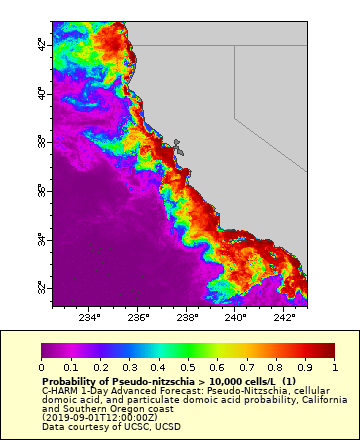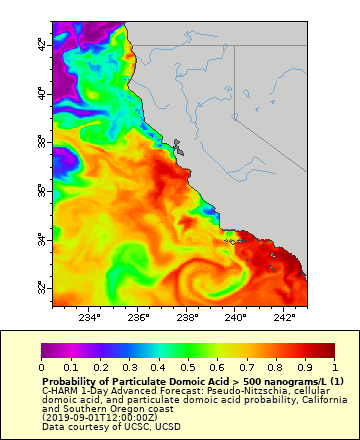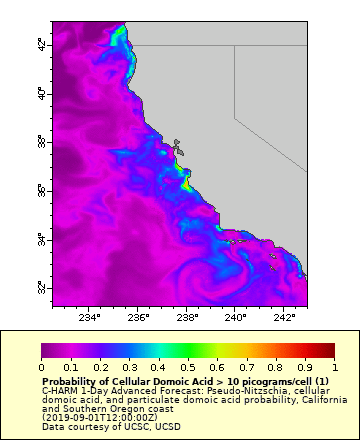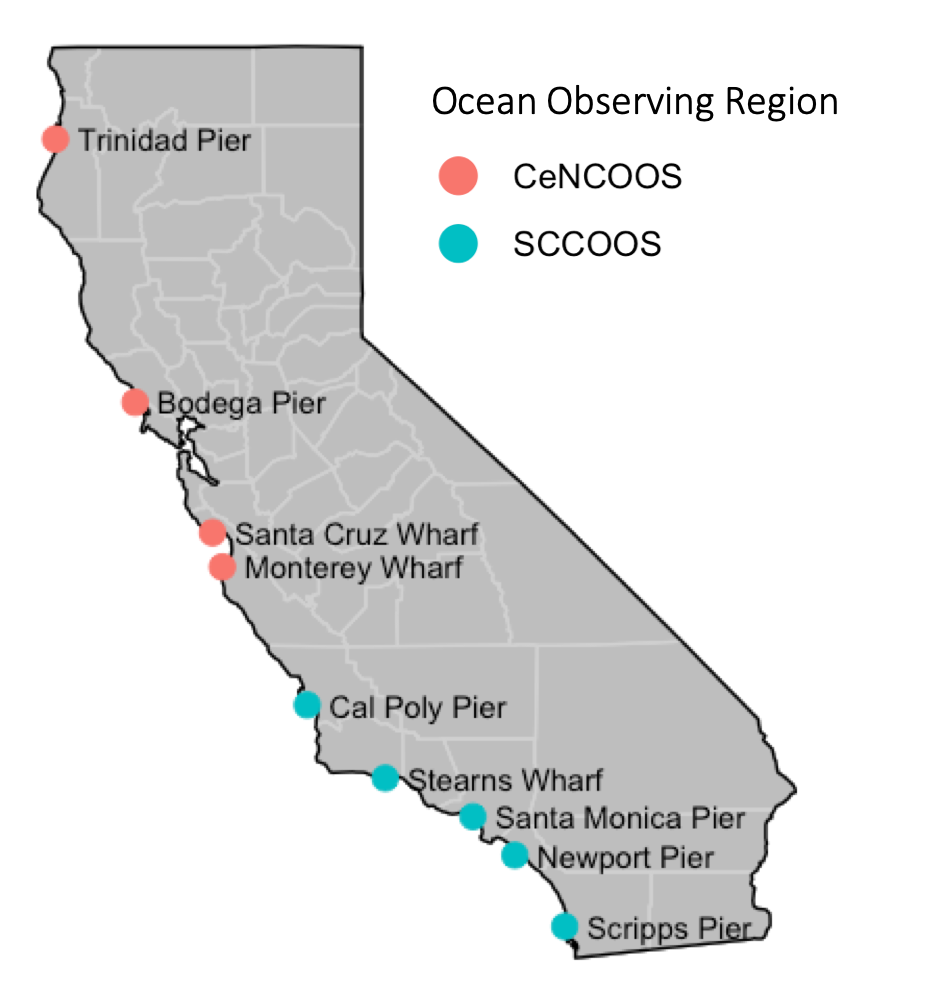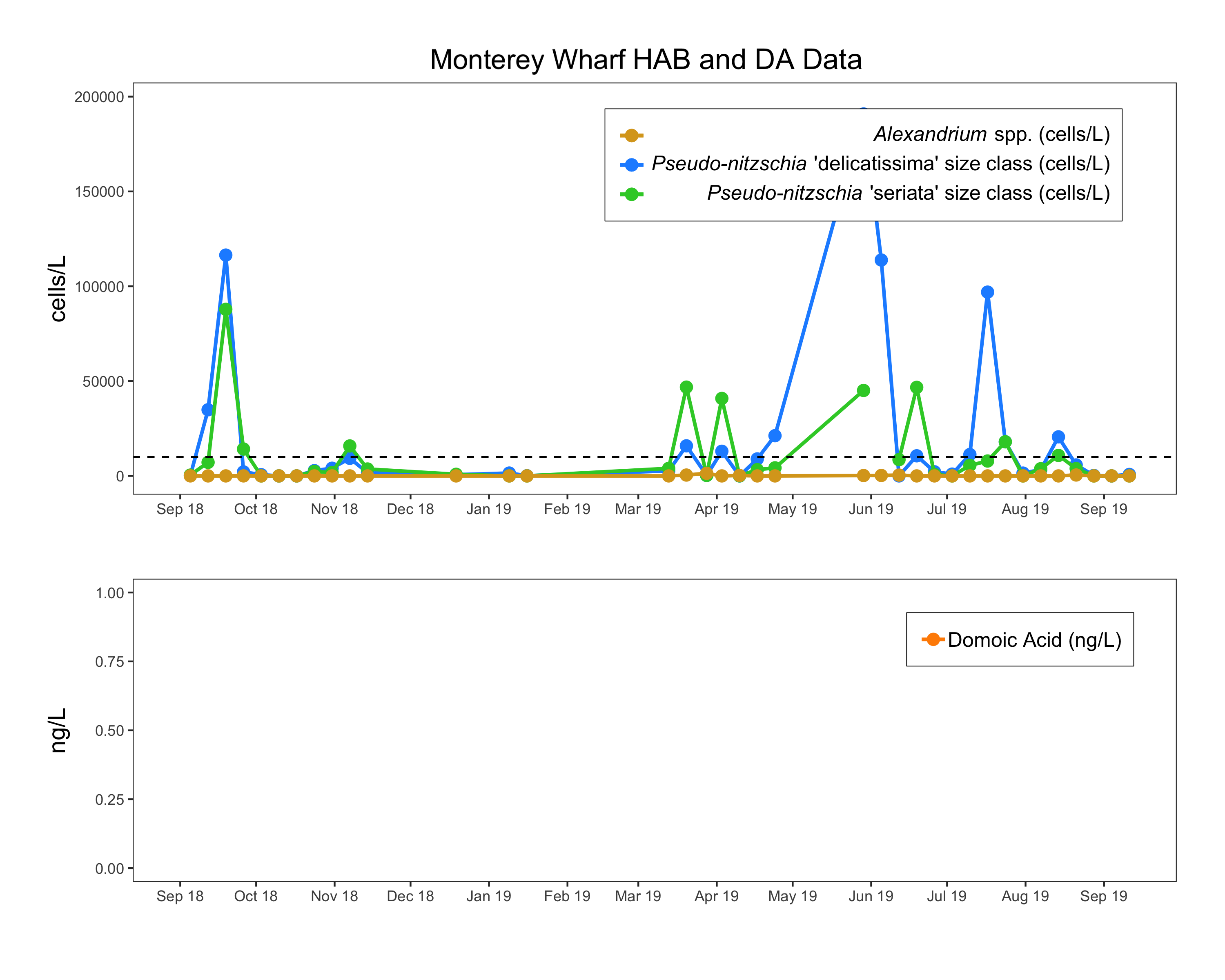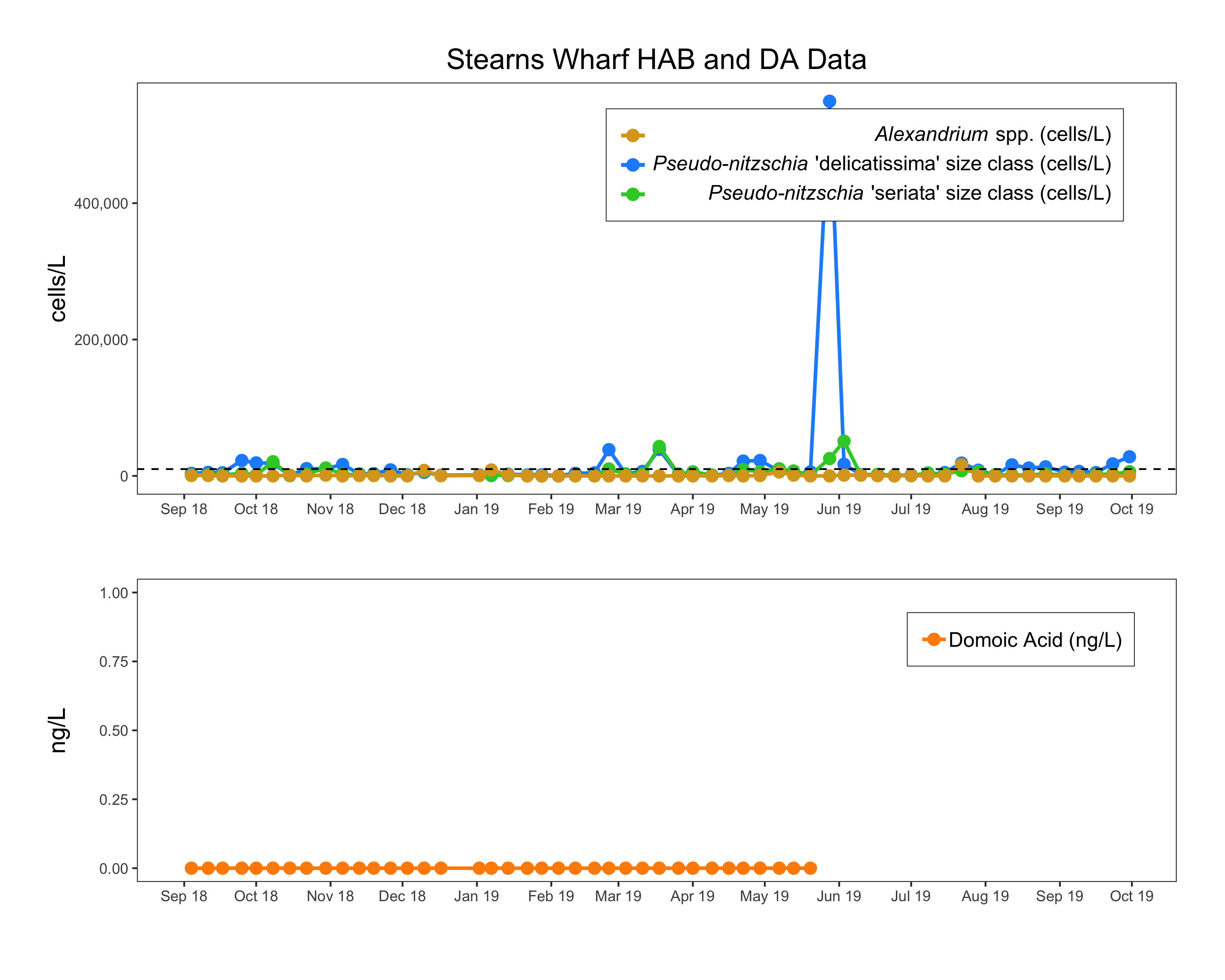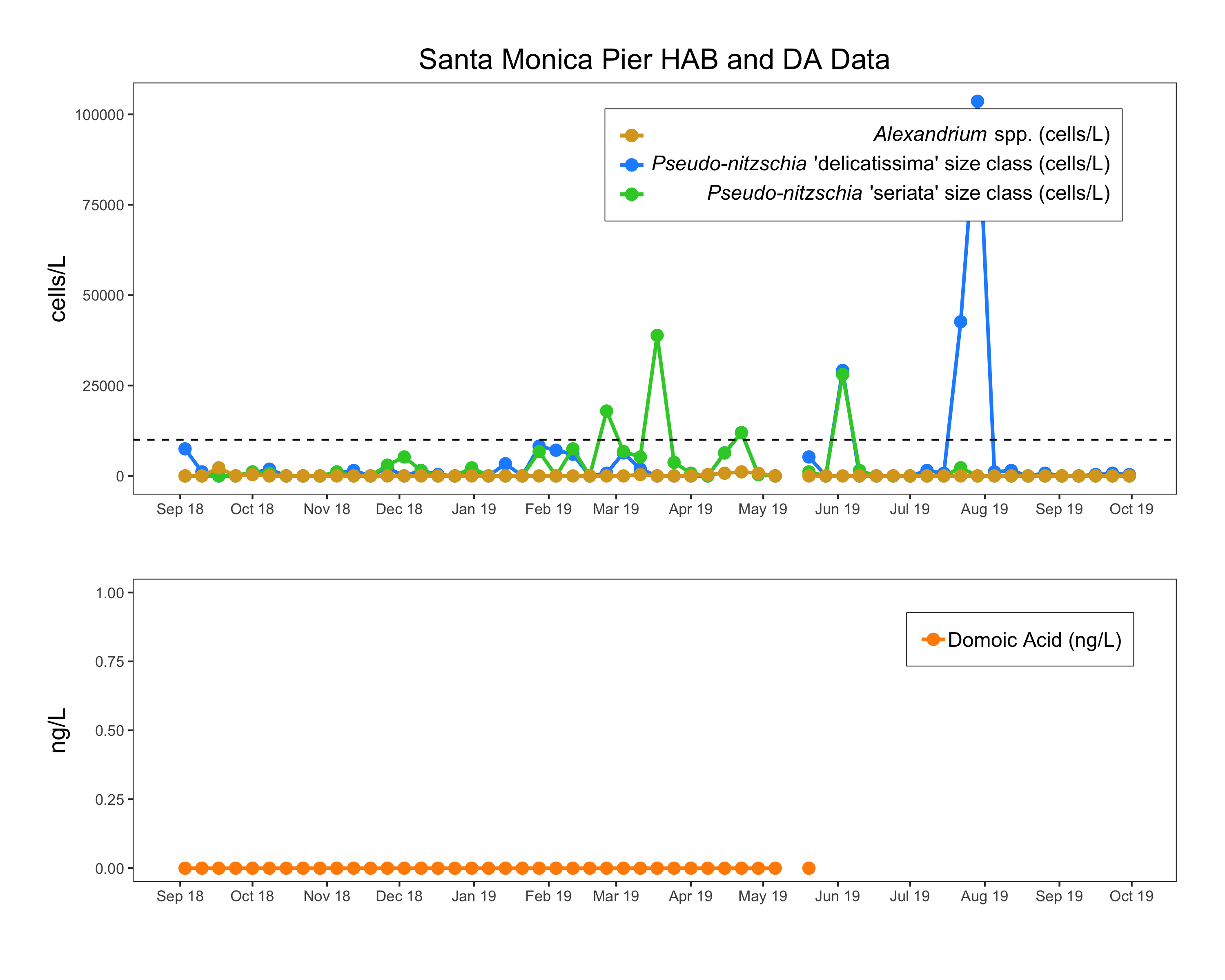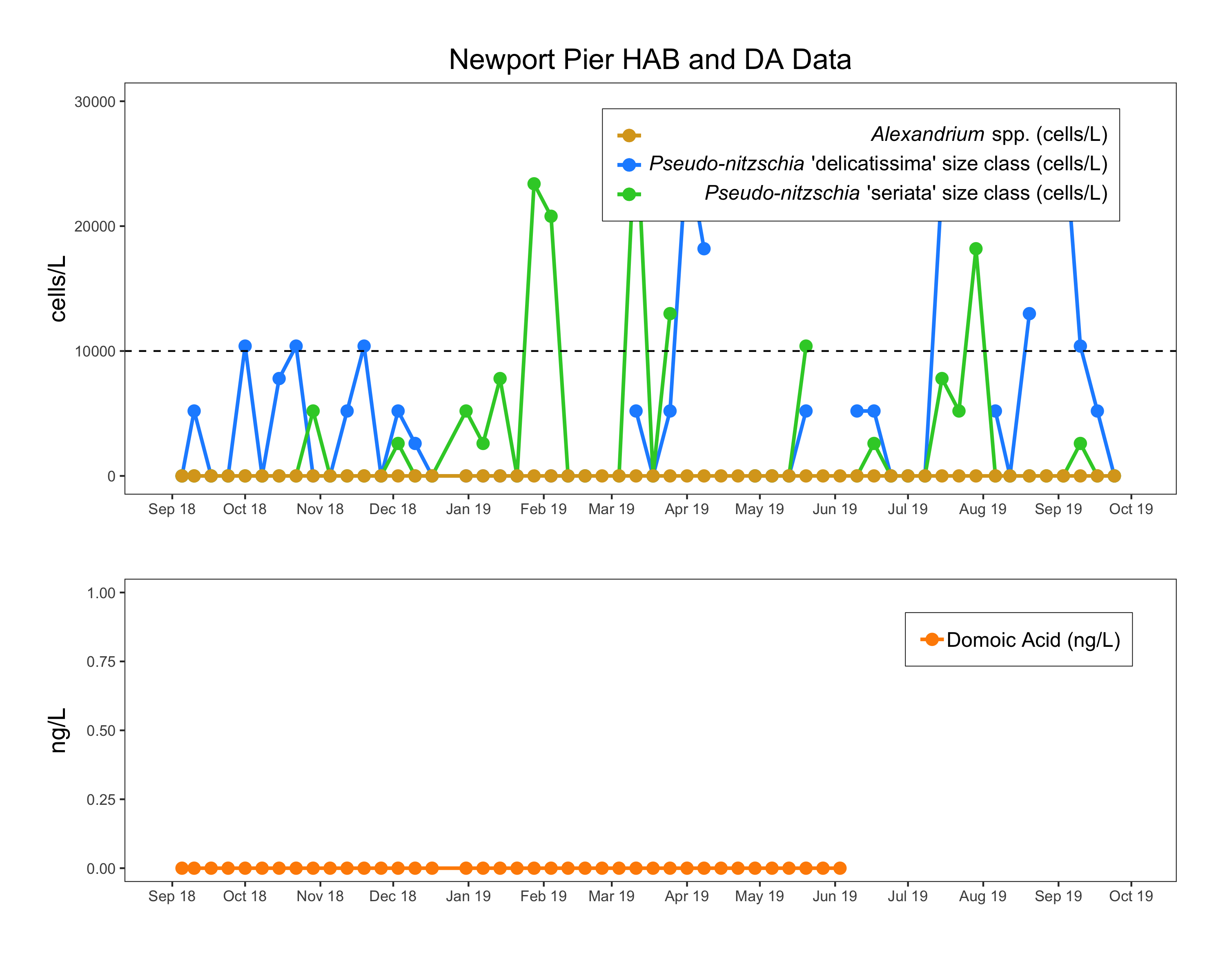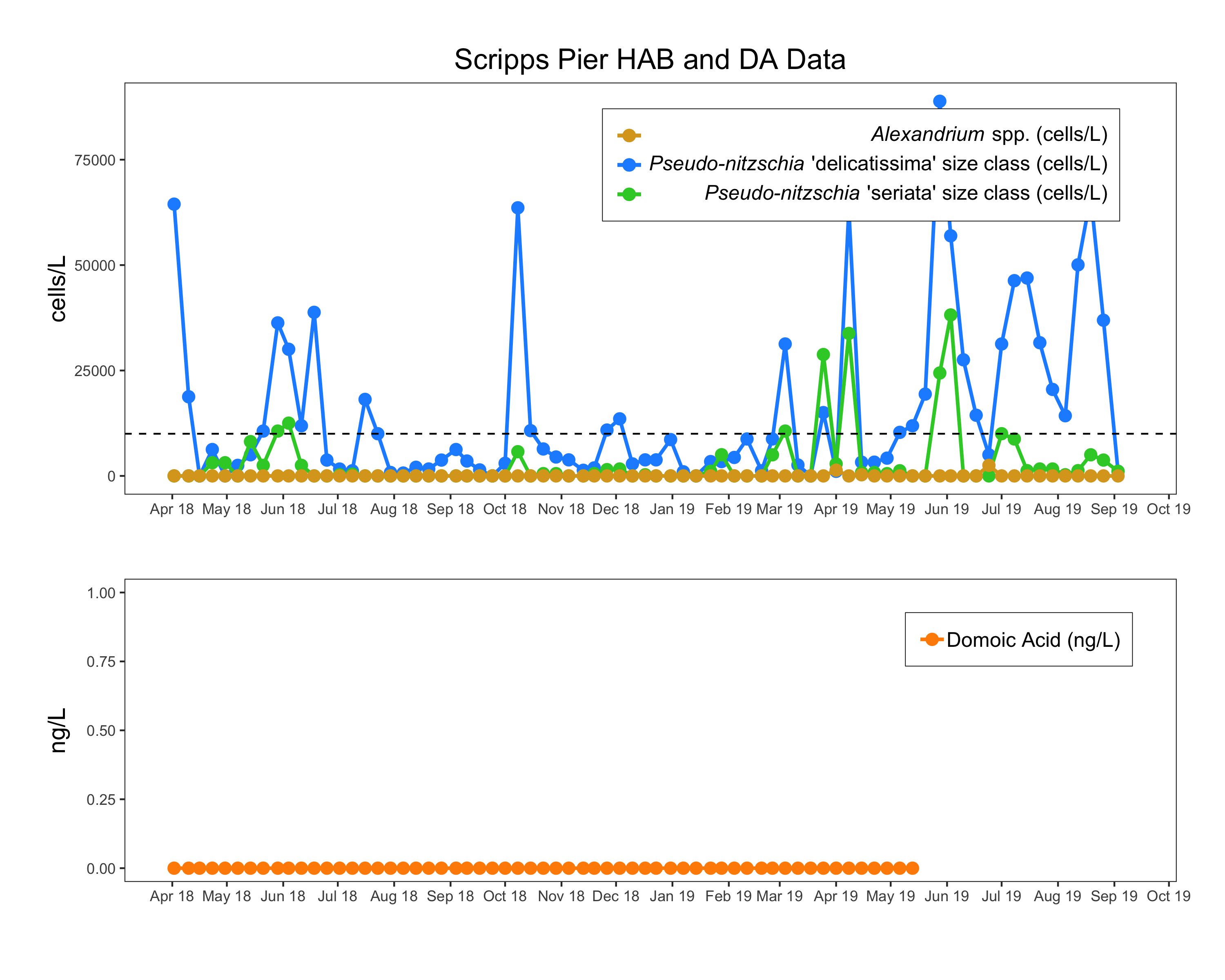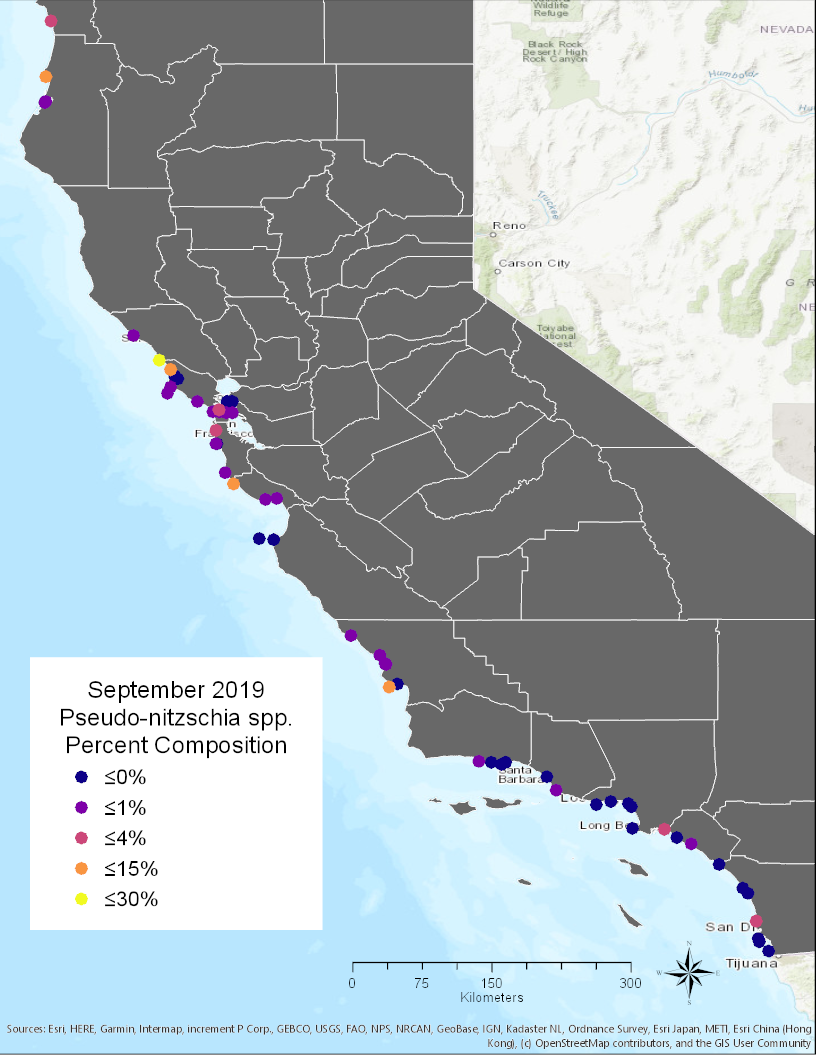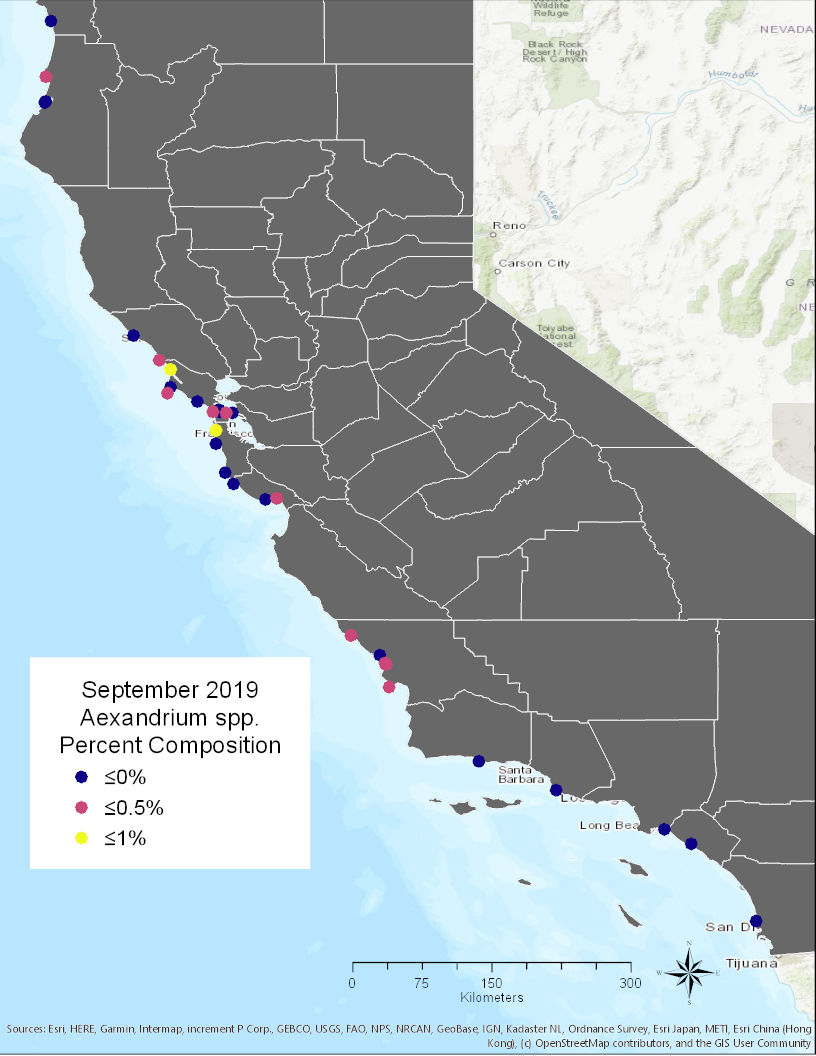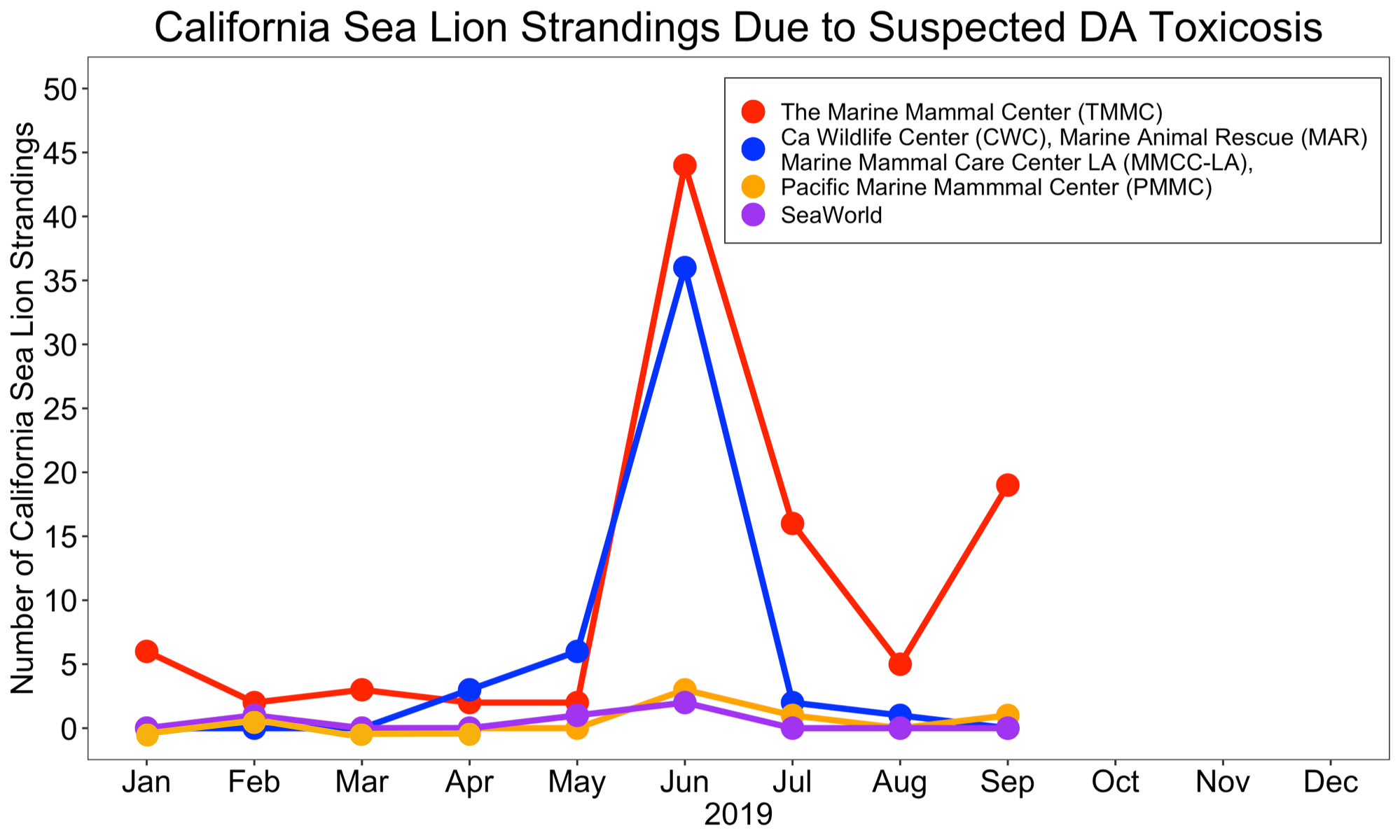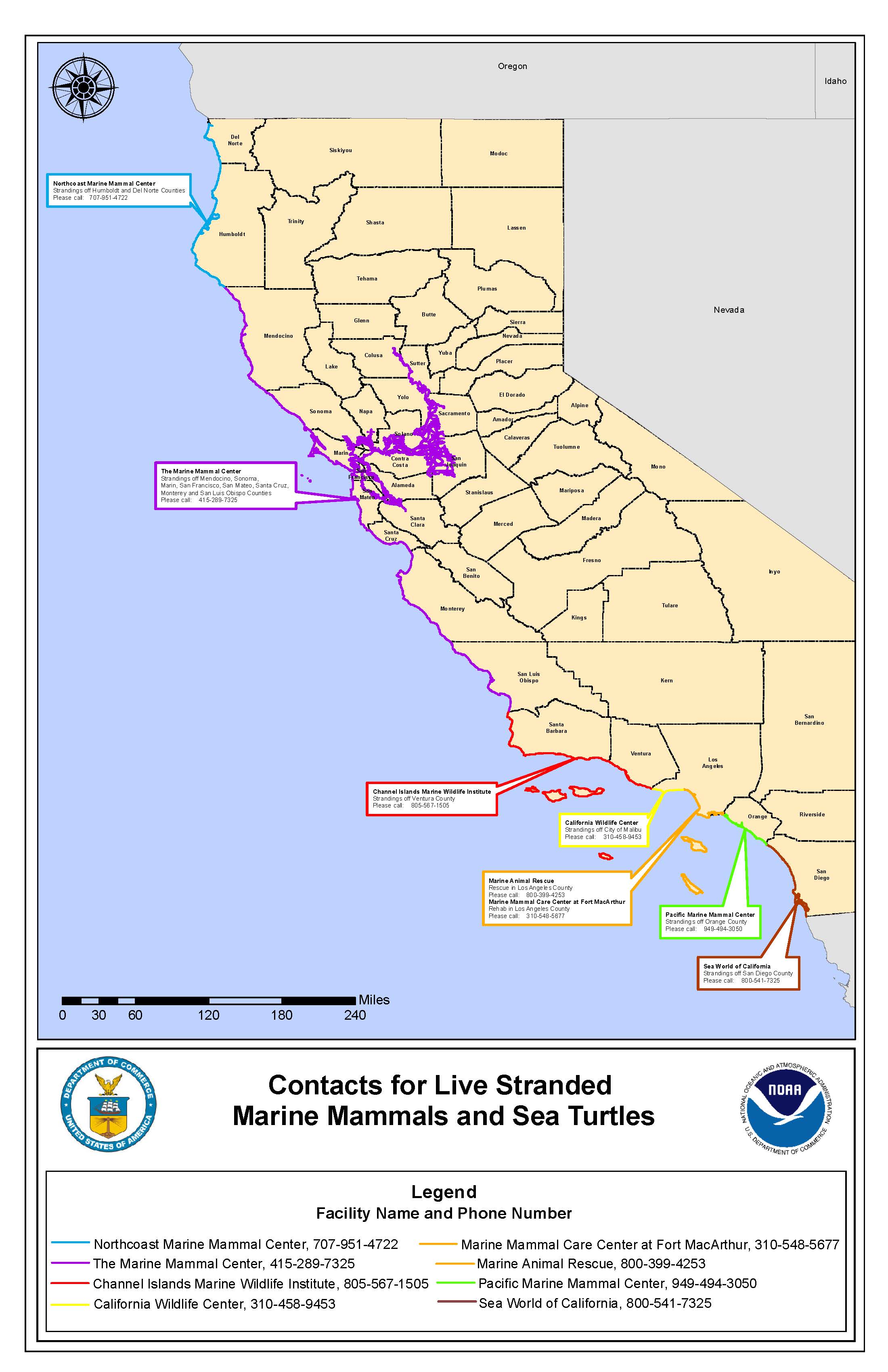Pseudo-nitzschia and Domoic Acid Predictions - C-HARM tells us where conditions are suitable for species of the diatom Pseudo-nitzschia spp. (all size classes) to grow well and where they might be more likely to produce domoic acid (DA). In September, suitable habitat for Pseudo-nitzschia spp. was spread throughout coastal California, as it was in August, although with variable degrees of growth potential evidenced by the model for the Southern California Bight and for the Sonoma Coast throughout the month. This suggests a more patchy abundance of cells in those regions. C-HARM predicted high probability of particulate DA (pDA) but very patchy particulate DA (pDA) throughout most of the state, with the greatest probabilities of high DA along sections of the Sonoma coastline, Half Moon Bay, Monterey Bay, and the Southern California Bight (including the Santa Barbara Channel and the transition region around Pt Conception). As in August, nearshore probabilities of pDA were low for the San Luis Obispo coast but high in offshore eddy-like patches. The notable difference from August was the decreasing likelihood of high pDA along the North Coast/Humboldt Coast region. C-HARM indicates very high probabilities in cellular DA (cDA) distributed in patches. These patches wax and wane over the course of the month but are persistently high along the Sonoma coastline and Marin County, Half Moon Bay, just south of Monterey Bay. Patches of high cDA probability around Pt. Conception and San Miguel Island appeared on and off in the SB Channel proper.
In comparison with the Harmful Algal Bloom Monitoring Alert Program (HABMAP) measurements where we have the September data already available, bloom levels of the P. "delicatissima" size class occurred at various times throughout the month in the Southern California Bight at Newport Beach Pier (Orange Co.) and Scripps Pier (San Diego Co.), Stearns Wharf in Santa Barbara, but not at the Santa Monica Pier. The P. "seriata" (i.e., more toxigenic) size class never reached bloom levels but showed an uptick in abundance at several southern sites, while P. delicatissima size class rose slightly at Cal Poly Pier (San Luis Obispo Co.) in late Sept. A similar uptick in P. seriata size class was seen at the Santa Cruz Wharf in September but below bloom levels. Of the HABMAP sites, DA data were only available for Santa Cruz Wharf where none was detected throughout the month of September, consistent with the low cDA predicted by C-HARM for the Monterey Bay area but inconsistent with the high pDA predicted for the area. Animal strandings potentially related to DA were concentrated in central California throughout September, consistent with the high cDA and pDA event probabilities predicted by C-HARM in this region but inconsistent with the low abundances of Pseudo-nitzschia spp. recorded at the Santa Cruz Wharf.
CDPH recorded their highest relative abundances of Pseudo-nitzschia seriata in Humboldt Bay area, the San Mateo Coast (Ano Nuevo Beach), and Sonoma Coast (Bodega Harbor) regions, as well as San Luis Obispo Co. where HABMAP recorded a slight rise in the non-toxigenic size class of Pseudo-nitzschia. As in August, Pseudo-nitzschia was not observed as a large proportion of the phytoplankton community in the Southern California Bight, although this is inconsistent with the high abundance values of the mostly non-toxigenic size class observed at Newport Beach Pier (Orange Co.) and Scripps Pier (San Diego Co.), and Stearns Wharf in Santa Barbara via the HABMAP pier sampling program, highlighting the patchy nature of phytoplankton species composition from day to day and site to site, as well as the difficulty associated with bulk Pseudo-nitzschia measurements that don't discriminate species. CDPH issued an Amnesic Shellfish Poisoning (ASP) warning from domoic acid on October 15th for Humboldt and Mendocino Counties.
Alexandrium - HABMAP records for Alexandrium spp. at pier sites. As in August, Cal Poly Pier (SLO Co.) was the only site showing a slight rise in Alexandrium spp. abundance in August. CDPH sampling, on the other hand, showed very slightly elevated relative abundance outside San Francisco Bay and near Bodega Bay. Lab results for of paralytic shellfish (PSP) toxins in shellfish led to an early September alert from CDPH on the risk of PSP toxins in mussels, clams, and whole scallops from Sonoma Co.
Note that data for some stations are not shown because they are not yet recorded in the public HABMAP archive.
Differentiating Pseudo-nitzschia species by light microscopy is difficult. For this reason, Pseudo-nitzschia "seriata" does not refer to an actual species but rather the larger size class of Pseudo-nitzschia, which is generally a more toxigenic group of species. Alternatively, Pseudo-nitzschia "delicatissima" refers to the smaller size class that is generally non-toxigenic. The dashed line on the plots demarcates the 10,000 cells/L "bloom" threshold designated here for Pseudo-nitzschia populations only.
More information on the statewide HAB network and forecasting system can be found here and on the SCCOOS HABMAP page.
Santa Cruz Wharf
Water samples were collected at Santa Cruz Wharf four times in the month of September. Pseudo-nitzschia seriata group and Alexandrium were detected below bloom levels. Domoic Acid was not detected in any of the samples. Santa Cruz Wharf does not count for Pseudo-nitzschia delicatissima group since they use genetic probes for P. australis and P. multiseries (both seriata group).
Monterey Wharf
Water samples were collected at Monterey Wharf two times in the month of September. Pseudo-nitzschia seriata group and Alexandrium spp. were not detected in any of the samples. Domoic Acid results are not yet available for Monterey Wharf.
Cal Poly Pier
Water samples were collected at Cal Poly Pier four times in the month of September. Pseudo-nitzschia delicatissima group was detected below bloom levels on September 15th and 22nd. Domoic Acid results are not yet available for the months of July, August and September.
Stearns Wharf
Water samples were collected at Stearns Wharf five times in the month of September. Pseudo-nitzschia delicatissima group was detected above bloom levels on September 23rd and 30th. Pseudo-nitzschia seriata group was detected below bloom levels and Alexandrium spp. were not detected in any of the samples. Domoic Acid results are not yet available for Stearns Wharf.
Santa Monica Pier
Water samples were collected at Santa Monica five times in the month of September. Pseudo-nitzschia delicatissima group was detected below bloom levels and Pseudo-nitzschia seriata group and Alexandrium spp. were not detected in any of the samples. Domoic Acid results are not yet available.
Newport Beach Pier
Water samples were collected at Newport Beach Pier four times in the month of September. Pseudo-nitzschia delicatissima group was detected above bloom levels on September 3rd and 10th. Pseudo-nitzschia seriata group was detected below bloom levels and Alexandrium spp. were not detected in any of the samples. Domoic Acid results are not yet available.
Scripps Pier
Water samples were collected at Scripps Pier four times in the month of September but results are only available for September 3rd where Pseudo-nitzschia deli and seriata were detected below bloom levels and Alexandrium spp. were not detected. Particulate domoic acid results are not yet available for Scripps Pier for June - September.
CDPH observations for Pseudo-nitzschia spp. and Alexandrium spp.
Please note CDPH recently moved to only reporting Pseudo-nitzschia of the seriata complex and not all Pseudo-nitzschia spp. as previously provided.
From 1-30 September 2019, water samples were collected by volunteers and sent to the California Department of Public Health (CDPH) for analysis. Pseudo-nitzschia seriata were detected in 53 of the 112 samples. Pseudo-nitzschia seriata were recorded at Common density levels in three of the samples:
- September 20th at Bodega Harbor, USCG Dock (30% composition)
- September 13th at Port San Luis, Diablo Cove (15% composition)
- September 12th at Ano Nuevo Beach (10% composition)
Alexandrium spp. were detected in 17 of 59 samples in the month of September at low density levels. You can also view CDPH weekly map layers of Pseudo-nitzschia and Alexandrium here.
Data are provided by the California Department of Public Health, Environmental Management Branch.
CDPH and OEHHA Health Advisories
The California Department of Public Health (CDPH) advised consumers on September 4th not to eat sports-harvested mussels, clams, or whole scallops from Sonoma county due to the threat of Paralytic Shellfish Poisoning (PSP). A warning for Amnesic Shellfish Poisoning (ASP) in mussels due to the risk of domoic acid was released on October 15th for Humboldt and Mendocino counties. The annual mussel quarantine remains in effect through October 31st.
For the latest closures and updates, please visit the CDFW Health Advisories page as a central location of information related to CDPH and/or OEHHA health advisories.
On July 30, 2019 the Office of Environmental Health Hazard Assessment (OEHHA) hosted the Domoic Acid Wbinar: Research on Effects of Repeat Low-Level Exposures and Its Implications for Human Toxicity. The recorded webinar can be found here.
California Marine Mammal and Seabird Strandings from Suspected DA Toxicosis
Domoic acid (DA) is a potent neurotoxin produced by some diatom species of the genus Pseudo-nitzschia. Species exposed to DA can result in seizures, epilepsy, cardiomyopathy, and death depending upon the ingested dose. DA toxicosis commonly occurs in California Sea Lions (Zalophus californianus), presumably due to a combination of foraging behavior and seasonal movements. The Marine Mammal Center (TMMC), the California Wildlife Center (CWC), the Marine Mammal Care Center Los Angeles (MMCC-LA), Marine Animal Rescue (MAR), the Pacific Marine Mammal Center (PMMC), and SeaWorld act like an emergency room by working to rescue and rehabilitate sick and injured marine mammals, seabirds, and sea turtles.
Among the six rehabilitation centers we have data for a total of 31 marine mammal strandings presented with symptoms of domoic acid toxicosis in the month of September.
CWC, MAR, MMCC-LA, and SeaWorld did not record any strandings due to suspected DA in September.
September marine mammal strandings suspected due to DA toxicosis occurred in the following counties:
- Mendocino County (TMMC)
- September 11, subadult male California Sea Lion
- Sonoma County (TMMC)
- September 11, juvenile male California Sea Lion
- September 29, subadult female Northern Fur Seal
- Marine County (TMMC)
- September 13, adult female California Sea Lion
- September 17, adult female Northern Fur Seal
- September 21, adult female California Sea Lion
- Contra Costa County
- September 19th, adult female California Sea Lion
- Alameda County (TMMC)
- September 30, subadult male California Sea Lion
- San Francisco County (TMMC)
- September 8, adult female Northern Fur Seal
- September 16, adult female Northern Fur Seal
- September 16, adult female Northern Fur Seal
- San Mateo County (TMMC)
- September 7, subadult male Northern Fur Seal
- September 15, adult female California Sea Lion
- September 18, adult female Northern Fur Seal
- September 19, adult female Northern Fur Seal
- September 21, adult female Northern Fur Seal
- September 24, subadult male California Sea Lion
- September 26, adult female California Sea Lion
- September 27, adult female California Sea Lion
- September 29, subadult male California Sea Lion
- September 30, subadult male California Sea Lion
- Santa Cruz County (TMMC)
- September 4, subadult male Northern Fur Seal
- September 14, adult female Northern Fur Seal
- September 23, adult female California Sea Lion
- Monterey County (TMMC)
- September 22, subadult male California Sea Lion
- September 23, subadult male California Sea Lion
- September 23, adult female California Sea Lion
- September 24, subadult male California Sea Lion
- September 38, subadult male California Sea Lion
- Orange County County (PMMC)
- September 19, adult female California Sea Lion
At this time we do not have data from the North Coast Marine Mammal Center or the Channel Islands Marine Wildlife Institute.
California Sea Bird Strandings from Suspected DA Toxicosis
Data coming soon from Wildlife Rehabilitation Medical Database (WRMD) and BeachCOMBERS.

